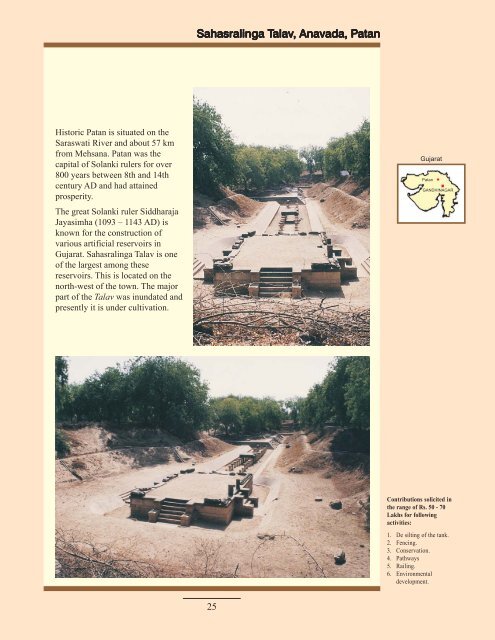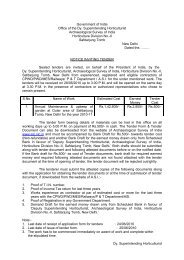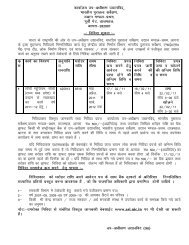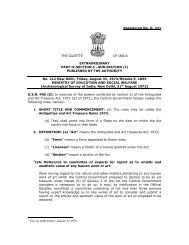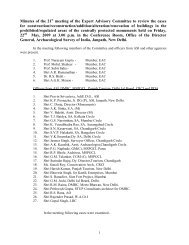Gujarat
Gujarat
Gujarat
Create successful ePaper yourself
Turn your PDF publications into a flip-book with our unique Google optimized e-Paper software.
Historic Patan is situated on the<br />
Saraswati River and about 57 km<br />
from Mehsana. Patan was the<br />
capital of Solanki rulers for over<br />
800 years between 8th and 14th<br />
century AD and had attained<br />
prosperity.<br />
The great Solanki ruler Siddharaja<br />
Jayasimha (1093 – 1143 AD) is<br />
known for the construction of<br />
various artificial reservoirs in<br />
<strong>Gujarat</strong>. Sahasralinga Talav is one<br />
of the largest among these<br />
reservoirs. This is located on the<br />
north-west of the town. The major<br />
part of the Talav was inundated and<br />
presently it is under cultivation.<br />
Sahasralinga Sahasralinga T TTalav<br />
T alav alav, alav , Anavada, Anavada, Anavada, P PPatan<br />
P atan<br />
25<br />
<strong>Gujarat</strong><br />
Patan<br />
GANDHINAGAR<br />
Contributions solicited in<br />
the range of Rs. 50 - 70<br />
Lakhs for following<br />
activities:<br />
1. De silting of the tank.<br />
2. Fencing.<br />
3. Conservation.<br />
4. Pathways<br />
5. Railing.<br />
6. Environmental<br />
development.
<strong>Gujarat</strong><br />
GANDHINAGAR<br />
Sarkhej (Ahmedabad)<br />
Contributions solicited in<br />
the range of Rs. 50 - 70<br />
Lakhs for following<br />
activities:<br />
1. Conservation.<br />
2. Environmental<br />
development.<br />
Group of Monuments, Sarkhej, Ahmedabad<br />
During the reign of Sultan Muhammad Shah II ( AD 1442-51), the<br />
construction of a large structural complex was started at Sarkhej.<br />
It is located about 10 km south west of Ahmedabad. The<br />
construction started in honour of the famous Saint Makhdum<br />
Shaikh Khattu (AD 1336-1445), who settled and died at Sarkhej.<br />
The whole complex comprises of several historical buildings, such<br />
as Tomb of Shaikh Ahmad Khattu, Great Mosque, Tank, Palace<br />
and Harem etc.<br />
26
Group Group of of Monuments, Monuments, Champaner Champaner and and P PPavagadh<br />
P avagadh<br />
Champaner is located at a distance of 50 km from<br />
Baroda and at the foothill of the Pavagadh hill. The<br />
historical monuments at Champaner consist of<br />
fortifications, some of which originate on the hill top<br />
and end on the plains.<br />
Pavagadh hill was a famous Hindu fortress under the<br />
Solanki kings of <strong>Gujarat</strong> followed by Khichi Chauhans.<br />
In AD 1484, Sultan Mahmud Begarah took possession<br />
of the fort and renamed it as Muhammadabad. The<br />
monuments are located on the Mauliya plateau, which<br />
is situated on the hill. The earliest temple, datable to<br />
10 th – 11 th century and dedicated to Lakulisa has only<br />
gudhamandapa and antarala remaining. Other temples<br />
belong to Hindu and Jaina sects and are datable to circa<br />
13 th – 15 th centuries AD. All temples are of the nagara<br />
style having garbhagriha, mandapa and an entrance<br />
porch. Pavagadh also boasts of several important<br />
monuments of medieval Islamic architecture.<br />
27<br />
<strong>Gujarat</strong><br />
GANDHINAGAR<br />
Champaner, Pavagadh<br />
Contributions solicited in<br />
the range of Rs. 200 - 300<br />
Lakhs for following<br />
activities:<br />
1. Conservation of<br />
monuments.<br />
2. Environmental<br />
development.<br />
3. Providing tourist<br />
facilities.
<strong>Gujarat</strong><br />
Anavada (Patan)<br />
GANDHINAGAR<br />
Contributions solicited in<br />
the range of Rs. 20 - 30<br />
Lakhs for following<br />
activities:<br />
1. Conservation of<br />
monuments.<br />
2. Environmental<br />
development.<br />
3. Providing tourist<br />
facilities.<br />
Rani-ki-Vav, Patan<br />
This magnificent step-well is believed to have been<br />
constructed by Udayamati, queen of the Solanki king<br />
Bhimadeva (AD 1022-1063). It had been partly damaged and<br />
silted up and only recently been de silted and fully exposed.<br />
This east facing, seven storied monument is 65 m long and<br />
consists of a long stepped corridor descending down to an<br />
underground tank. The structure is compartmented with four<br />
multi-storied pillared pavilions with a circular draw-well at<br />
the rear end.<br />
Fine sculptures embellish<br />
the corridor walls, pillared<br />
pavilions and the inner<br />
sides of the well. Of the<br />
original estimated 800<br />
sculptures, nearly 400 have<br />
survived. These comprise<br />
almost all Hindu gods and<br />
goddesses, a profusion of<br />
apsaras and miscellaneous<br />
themes including erotic<br />
scenes. Prominence is<br />
given to the image of<br />
Vishnu reclining on<br />
Adisesha which is depicted<br />
centrally in three registers,<br />
girdling the well.<br />
28


